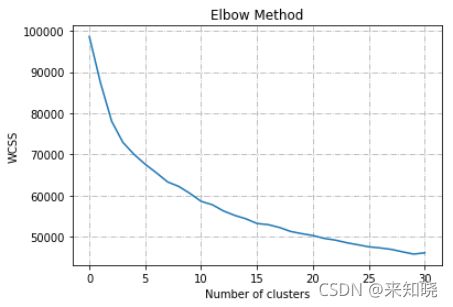机器学习:Kmeans聚类算法总结及GPU配置加速demo
机器学习:Kmeans聚类算法总结及GPU配置加速demo
-
- Kmeans算法介绍
- 版本1:利用sklearn的kmeans算法,CPU上跑
- 版本2:利用网上的kmeans算法实现,GPU上跑
- 版本3:利用Pytorch的kmeans包实现,GPU上跑
- 相关资料
Kmeans算法介绍
-
算法简介
- 该算法是一种贪心策略,初始化时随机选取N个质心,不断迭代,让周围元素到质心的误差累积和最小,从而找到质心或者说对应的簇。
-
核心步骤
- 先得到待分类的大量数据(多维向量)
- 初步尝试得到最佳的分类簇数量
- 根据最佳簇数量和随机起点作聚类
- 得到最佳簇划分的码矢,将其编制成固定顺序
- 计算得到个别数据对应的index,即码矢的索引序号
- 码矢的集合组成码本
-
评判指标
- 簇内相似度高,即被分类到某一簇的样本,离簇的距离足够小
- 簇间相似度低,即每个簇的差距较大,能表征更多信息
下面Python代码实践总结如下,分别布置在CPU和GPU上。
版本1:利用sklearn的kmeans算法,CPU上跑
-
好处
- 快速调用机器学习库,sklearn
- 适合进行码本训练和简单分类任务
-
劣势
- 问题当数据量大时,迭代速度较慢
-
参考链接:here
import module_kmeans
dir_in = r"/home/work/codebook_train_data/"
# module_kmeans.sf_kmeans(dir_in)
对应的调用脚本文件:sf_kmeans.py,内部代码如下:
# -*- coding: utf-8 -*-
import sys
import os
import wave
from scipy.io import wavfile
import numpy as np
import pandas as pd
import matplotlib.pyplot as plt
# error
# from sklearn.datasets.samples_generator import make_blobs
from sklearn.datasets import make_blobs
from sklearn.cluster import KMeans
def sf_kmeans(path):
data = pd.read_csv(path + 'sf_taylor.csv')
X = data.iloc[:, 0:16] # get low 16 values
# X, y = make_blobs(n_samples=300, centers=4, cluster_std=0.60, random_state=0)
# plt.scatter(X[:, 0], X[:, 1])
# plt.close()
# plt.figure()
max_range = 1025
wcss = []
for i in range(1, max_range):
kmeans = KMeans(n_clusters=i, init='k-means++', max_iter=300, n_init=10, random_state=0)
kmeans.fit(X)
wcss.append(kmeans.inertia_)
plt.figure()
plt.grid(linestyle='-.')
plt.title('Elbow Method')
plt.xlabel('Number of clusters')
plt.ylabel('WCSS')
plt.plot(range(1, max_range), wcss)
plt.show()
plt.figure()
kmeans = KMeans(n_clusters=4, init='k-means++', max_iter=300, n_init=10, random_state=0)
pred_y = kmeans.fit_predict(X)
plt.grid(linestyle='-.')
plt.scatter(X[:, 0], X[:, 1])
plt.scatter(kmeans.cluster_centers_[:, 0], kmeans.cluster_centers_[:, 1], s=300, c='red')
plt.show()
print(kmeans.labels_)
print(kmeans.cluster_centers_)
print('done!')
版本2:利用网上的kmeans算法实现,GPU上跑
- 好处:
- 能解决迭代速度问题
- 劣势:
- 随之而来的问题是,该算法实现精度较差
- 无法达到与本地CPU跑的sklearn的kmeans算法效果
- 参考链接:here
import torch
import time
from tqdm import tqdm
import pandas as pd
# import pdb # for debug
# pdb.set_trace()
class KMEANS:
def __init__(self, n_clusters=20, max_iter=None, verbose=True,device = torch.device("cuda")):
self.n_cluster = n_clusters # n_clusters > 0
self.n_clusters = n_clusters
self.labels = None
self.dists = None # shape: [x.shape[0],n_cluster]
self.centers = None
self.variation = torch.Tensor([float("Inf")]).to(device)
self.verbose = verbose
self.started = False
self.representative_samples = None
self.max_iter = max_iter
self.count = 0
self.device = device
def fit(self, x):
# 随机选择初始中心点,想更快的收敛速度可以借鉴sklearn中的kmeans++初始化方法
init_row = torch.randint(0, x.shape[0], (self.n_clusters,)).to(self.device)
init_points = x[init_row]
self.centers = init_points
while True:
# 聚类标记
self.nearest_center(x)
# 更新中心点
self.update_center(x)
if self.verbose:
print(self.variation, torch.argmin(self.dists, (0)))
if torch.abs(self.variation) < 1e-3 and self.max_iter is None:
break
elif self.max_iter is not None and self.count == self.max_iter:
break
self.count += 1
self.representative_sample()
def nearest_center(self, x):
labels = torch.empty((x.shape[0],)).long().to(self.device)
dists = torch.empty((0, self.n_clusters)).to(self.device)
for i, sample in enumerate(x):
dist = torch.sum(torch.mul(sample - self.centers, sample - self.centers), (1))
labels[i] = torch.argmin(dist)
dists = torch.cat([dists, dist.unsqueeze(0)], (0))
self.labels = labels
if self.started:
self.variation = torch.sum(self.dists - dists)
self.dists = dists
self.started = True
def update_center(self, x):
centers = torch.empty((0, x.shape[1])).to(self.device)
for i in range(self.n_clusters):
mask = self.labels == i
cluster_samples = x[mask]
centers = torch.cat([centers, torch.mean(cluster_samples, (0)).unsqueeze(0)], (0))
self.centers = centers
def representative_sample(self):
# 查找距离中心点最近的样本,作为聚类的代表样本,更加直观
self.representative_samples = torch.argmin(self.dists, (0))
def sf_kmeans(matrix,device):
max_range = 4
wcss = []
gpu_speeds = []
print(matrix.shape)
print(matrix)
print('\n')
for i in tqdm(range(1, max_range + 1)):
# print('%d'%(i), end='\r')
a = time.time()
kmeans = KMEANS(n_clusters=i, max_iter=None, verbose=False, device=device)
kmeans.fit(matrix)
# wcss.append(kmeans.inertia_)
wcss.append(torch.sum(kmeans.dists))
# print(torch.sum(kmeans.dists) / k)
# print(kmeans.variation)
b = time.time()
speed = (b - a) / kmeans.count
gpu_speeds.append(speed)
print(kmeans.centers)
print(kmeans.dists)
print(torch.sum(kmeans.dists))
print('\n')
# plt.figure()
plt.grid(linestyle='-.')
plt.title('Elbow Method')
plt.xlabel('Number of clusters')
plt.ylabel('WCSS')
plt.plot(range(max_range), wcss)
plt.show()
plt.figure()
l2, = plt.plot(range(max_range), gpu_speeds, color='g',label = "GPU")
plt.xlabel("num_features")
plt.ylabel("speed(s/iter)")
plt.title("Speed with cuda")
plt.legend(handles = [l2], labels = ['GPU'], loc='best')
def choose_device(cuda=False):
if cuda:
device = torch.device("cuda:0")
else:
device = torch.device("cpu")
return device
if __name__ == "__main__":
import matplotlib.pyplot as plt
dir_in = r"/home/work/codebook_train_data/"
# data = pd.read_csv(dir_in + 'sf_taylor.csv')
# df = data.iloc[:, 0:16] # get low 16 values
# print(df.dtypes)
# print(type(data))
# np_data = df.values
data = pd.read_csv(dir_in + 'Mall_Customers.csv')
np_data = data.iloc[1 : 6, [3, 4]].values
device = choose_device(True)
matrix = torch.from_numpy(np_data).to(device)
matrix = matrix.float()
# matrix = torch.rand((10000, 10)).to(device)
sf_kmeans(matrix, device)
版本3:利用Pytorch的kmeans包实现,GPU上跑
调用Pytorch现成的kmeans包,进行修改。
-
好处:
- 能解决迭代速度问题
- 达到与sklearn相同的精度结果
-
package name:kmeans-pytorch -
相关资料:ref1
-
相关资料:ref2
-
以下代码含画图及对比
!pip install kmeans-pytorch
import torch
import numpy as np
import time
# from tqdm import tqdm
import pandas as pd
# from kmeans_pytorch import kmeans
from module_pytorch_kmeans import kmeans
import matplotlib.pyplot as plt
def choose_device(cuda=False):
if cuda:
device = torch.device("cuda:0")
else:
device = torch.device("cpu")
return device
def sf_kmeans(matrix,device, dims):
max_range = 40
wcss = []
gpu_speeds = []
# print(matrix.shape)
# print(matrix)
# print('\n')
# data
# data_size, dims, num_clusters = 1000, 2, 3
# x = np.random.randn(data_size, dims) / 6
# x = torch.from_numpy(x)
for n_clusters in range(2, max_range + 1):
a = time.time()
# kmeans
cluster_ids_x, cluster_centers, iters = kmeans(
X=matrix, num_clusters=n_clusters, distance='euclidean', tqdm_flag=False, device=torch.device('cuda:0')
)
# iter_limit=500,
# print(cluster_ids_x)
# print(cluster_centers)
# print('\n')
dists = torch.empty((0, dims)).to(device)
for i, sample in enumerate(matrix):
# 0按行追加扩展, 1按列追加扩展
id = cluster_ids_x[i]
dist = torch.mul(sample.to(device) - cluster_centers[id].to(device), sample - cluster_centers[id].to(device))
dists = torch.cat([dists, dist.unsqueeze(0)], (0))
print(torch.sum(dists))
# print('\r{}'.format(torch.sum(dists)), end='')
wcss.append(torch.sum(dists))
b = time.time()
speed = (b - a) / iters
gpu_speeds.append(speed)
# print('\n')
# print(wcss)
# print(gpu_speeds)
# plt.figure()
plt.grid(linestyle='-.')
plt.title('Elbow Method')
plt.xlabel('Number of clusters')
plt.ylabel('WCSS')
plt.plot(range(max_range - 1), wcss)
plt.show()
plt.figure()
l2, = plt.plot(range(max_range - 1), gpu_speeds, color='g',label = "GPU")
plt.xlabel("num_features")
plt.ylabel("speed(s/iter)")
plt.title("Speed with cuda")
plt.legend(handles = [l2], labels = ['GPU'], loc='best')
if __name__ == "__main__":
dir_in = r"/home/work/codebook_train_data/"
data = pd.read_csv(dir_in + 'sf_large.csv')
dims = 8
df = data.iloc[:, 0:dims] # get low 16 values
# print(df.dtypes)
# print(type(data))
np_data = df.values
# data = pd.read_csv(dir_in + 'Mall_Customers.csv')
# np_data = data.iloc[1 : 6, [3, 4]].values
device = choose_device(True)
matrix = torch.from_numpy(np_data).to(device)
matrix = matrix.float()
# matrix = torch.rand((10000, 10)).to(device)
sf_kmeans(matrix, device, dims)
输出提示如下:
…
tensor(3.3288e+08, device=‘cuda:0’)
tensor(2.3872e+08, device=‘cuda:0’)
tensor(1.9115e+08, device=‘cuda:0’)
tensor(1.6357e+08, device=‘cuda:0’)
tensor(1.4616e+08, device=‘cuda:0’)
…
相关资料
- K-means Clustering Python Example
- K-means(K均值)
- scikit-learn之kmeans应用及问题
- 用scikit-learn学习K-Means聚类
- kmcuda: GPU加速 Kmeans
- In-depth Intuition of K-Means Clustering Algorithm in Machine Learning
